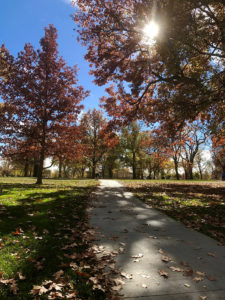BY MATT SALIS
The snow crunched under our boots as we walked briskly through the grove of giant evergreen trees at the north end of Washington Park. It was cold, and my insulated coffee cup was almost empty. My nine-year-old son, Joey, had to trot a little to keep up with my man-on-a-mission walking pace. The predawn light was getting brighter. The sun would be on the horizon in a minute or two, and we did not want to miss it. As we approached Smith Lake and looked for the best spot on the west side near Downing Street, the geese swam in pairs and honked at the start of the new day. We chose a bench, brushed off the snow with our gloves, sat on the edge and stared at tops of the trees across the pond on the east side of the park, and the roofs of the houses across Franklin Street just beyond.
 It was Easter Sunday 2016, and for reasons that I can no longer remember exactly, I was determined to see the dawning of the new day. We had planned to attend the Easter sunrise service at Red Rocks – something my family had not yet done in our twelve years as Denver residents – but the storm late in the last week had transformed the amphitheater into a big bowl of snow rendering it useless as a gathering place for humans.
It was Easter Sunday 2016, and for reasons that I can no longer remember exactly, I was determined to see the dawning of the new day. We had planned to attend the Easter sunrise service at Red Rocks – something my family had not yet done in our twelve years as Denver residents – but the storm late in the last week had transformed the amphitheater into a big bowl of snow rendering it useless as a gathering place for humans.
A red glow appeared just above the roofline of one of the houses. It was agonizing to wait for the first ray of light to appear. Once it did, however, the rest of the bright orange orb appeared rapidly before our eyes. It was beautiful – the sun and the trees and the lake and the geese and the snow – all in this urban setting with the snow-capped mountain scene to the west. Breathtaking.
“OK, Joey, that was beautiful, but let’s go…we gotta hustle!” And we were off – trudging and snow crunching and trotting briskly back home. There was breakfast to eat and showers to take and church to attend and more coffee to drink.
We had a purpose that morning. As is so often the case, our beloved Washington Park was there to fulfill a need for us. Red Rocks is closed and we need to see the sunrise – to Wash Park we go! Let’s go for a bike ride – three laps around Wash Park sounds perfect! Happy Birthday, Nick! We got you this remote-control helicopter. Let’s go to the meadow at Wash Park for its first flight! The park is there for us, to enhance the living of our lives, to help us accomplish something, to fulfill a purpose.
Shortly before they died, my grandparents visited us in Denver. They had never been to the western U.S., and we wanted to show them all the beauty our state has to offer. We took them to the mountains to see the golden aspen leaves. We took them to Red Rocks and through Clear Creek Canyon and all around Denver. And, of course, we took them to the largest flower garden in the City of Denver on the west side of Wash Park. Our purpose that day was natural beauty in an urban setting, and, as always, the park delivered.
When our kids were babies, we took them to the playground on the south side of Wash Park. When they were toddlers, we transitioned to the playground near the boat house. When we felt it unlikely they would drown in a foot of lazily running water, we taught them to hunt crawdads in City Ditch. When they were ready to play soccer, basketball, volleyball and flag football, we joined teams at the Wash Park Rec. Center. When our oldest child finished fifth grade at Steele Elementary, we attended a year-end party at the park picnic area near the fire station. And every time I decide I need to get in shape and take-up the self-inflicted punishment called running, it is around the 2.6 mile crushed gravel lap-of-misery I jog.
Wash Park has been a blessing to my family as we have raised our children in the shadows of its huge, century old trees. For so many of the purposes of our lives, its 165 acres have been the answer.
But what about the abundance the park has to offer when we have no purpose at all? Maybe that is what is truly special about Washington Park. We all know about the two big beautiful gardens, the two lakes, the two playgrounds, the recreation center and the boat house. What other more subtle treasures does the park have to offer? I take a slow, meandering, purpose-free walk from South High to Steele Elementary to find out.
My walk starts as the bell rings to end the school day at South. Hoards of kids spill across Louisiana Avenue into the southeast corner of the park. It occurs to me as I watch the onslaught of teenagers newly freed from the bondage of a day of school that this corner of the park is extended an extra block to the east almost like the park is stretching to touch the front doors of the school – like it is welcoming the students to an afternoon of leisure – asking them to be a part of the Wash Park story. They congregate in little groups and walk aimlessly. They tease and high-five and shove and laugh and hold hands with one another. Just like me, they seem to be enjoying the park without a purpose.
Just north of the mass of teenage humanity, across the bike path not far from Grasmere Lake, is a group of a dozen or so people on blankets in the shade of a huge tree with sprawling branches. The tree is very full of dark green leaves and provides the perfect shade for this casual gathering. I would bet the grass under their blankets is permanently matted-down as this spot is so perfect for a picnic or alfresco yoga class that its branches seem to be waving park people to come closer and visit for a while.
To the west of this gathering in the middle of Grasmere is a small island intended as a bird sanctuary. There are twenty or so big, beautiful white birds, many of whom are perched on the branches of the one dead and leafless tree on the island. I can’t help but wonder why they are perched in the dead tree. When I am in the park on a purpose, I would never have time to even notice.
Towards the middle of the park between the two lakes, the basketball court is very full with a pick-up game in progress and the next team waiting their turn to play the winners. As I walk by, a little shoving and shouting match sparks up. There are some unpleasant words, but the rest of the players settle-down the two skirmishers and play resumes. It is a reminder that this park means so many different things to so many different people. There are a half a dozen people strolling through the peaceful beauty of Mount Vernon Garden, while, well within earshot, a couple of riled-up competitors briefly shout unfortunate things at each other. Some might think the two settings are in conflict. To me, the two drastically different uses of the same city park are in perfect harmony for an urban setting in the middle of Denver.
As I cross the meadow, I look to the north and see the tops of three buildings that are a visual description of what is going on in Denver right now. If I stand at just the right angle, I can get the high-rise residential buildings bordering the park on Marion Parkway, the new high-rise residential towers under construction at Downing and Speer and the Wells Fargo “mailbox building” downtown lined-up next to each other in my sight-line. It looks very much like we are wedging a few thousand more people in between long-standing symbols of our population and our commerce. While I am unsure about the impact of the population explosion on our city overall, I am certain Wash Park will welcome the new residents with open arms.
Just before leaving the park I wander past the lily pond in its northeast corner. The sign there welcomes children to fish without a permit. As I am reading the fishing rules, two pre-teen boys come around the six-foot tall vegetation on the edge of the pond with fishing nets looking intently at the water as though they are hunting fish. It seems to me that poles, hooks and bait might be more effective, but they are certainly having fun, and isn’t that the whole point?
The park that is the centerpiece of our neighborhood provides a lot of benefits for us. It is there when we are in need of organized athletics, a great picnic spot, to show visitors the beauty of the gardens or if we need to lose a few pounds shuffling around the perimeter. If you want to appreciate Wash Park for more than a tool to achieve a goal, take a wandering walk with no purpose at all in mind. Even if you have been in the park hundreds of times, you might just truly see what it has to offer for the first time. Maybe you’ll fall in love with our urban neighborhood all over again, even if it is not on purpose.

